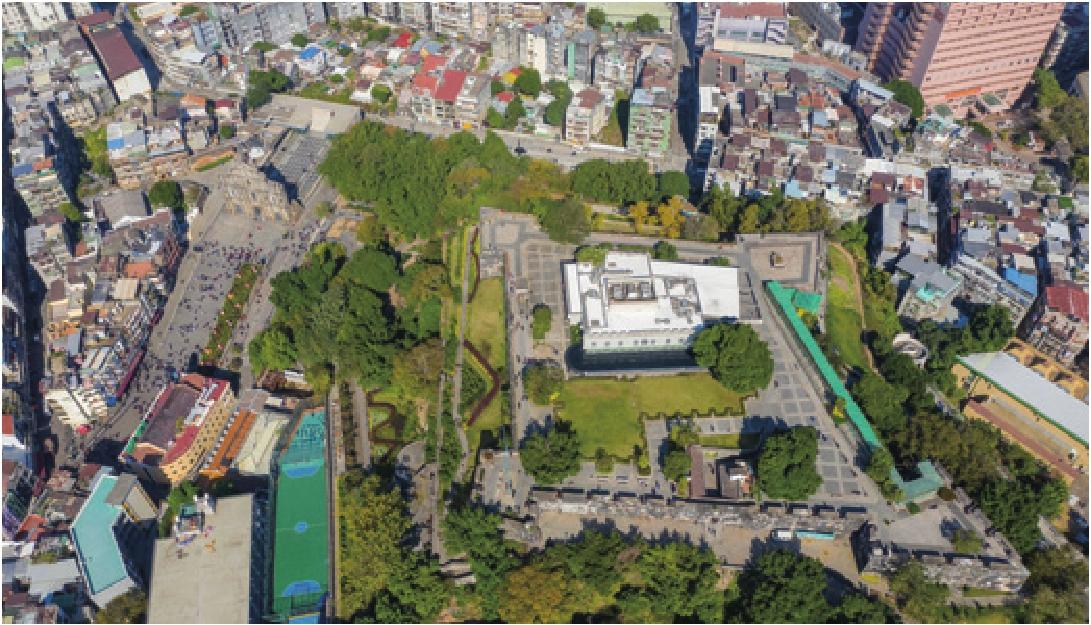CULTURE JUNCTURE
By Luo Xu

One afternoon in December, the square in front of Macaos landmark Ruins of St. Pauls came alive with music and dance to mark the opening of the 2019 Macao International Parade, an annual cultural event held since 2011.
This year, there was a special energy during the festivities as it was the 20th anniversary of Macaos return to the motherland.
Over the past centuries, Chinese and Western cultures have continued to amalgamate here. An important point on the Maritime Silk Road in ancient times and now an important platform to connect China with Portuguese-speaking countries, Macao has a unique international culture.
A melting pot
“Every year on May 16, there is a grand Feast of Na Tcha, attracting tens of thou- sands of viewers,” said Ip Tat, Chairman of the Na Tcha Temple Association in Macao.“Its as spectacular as the Blessed Virgins parade.”
Na Tcha, or Ne Zha, a Chinese deity of war, has a simple one-chamber temple near the Ruins of St. Pauls and during the annual feast, the image is taken out in a decorated vehicle to tour the city, followed by lion dancers. The Blessed Virgins parade refers to the annual street procession held as a tribute to the belief that Mary, mother of Jesus Christ, appeared before three children in a Portuguese town over 100 years ago.
In Macao, you see harmonious integration of Chinese and Western cultures. Chinese noodle restaurants sit next to Portuguese restaurants, Chinese-style houses are decorated with Western stained glass art and the Na Tcha Temple is filled with Western visitors. Every culture preserves its own characteristics in Macao while accepting and influencing other cultures.
The Historic Center of Macao, a cluster of about 20 heritage sites showcasing Chinese and Portuguese cultures, was inscribed on the UNESCO World Heritage List in 2005. “This success has strengthened local peoples cultural confidence based on confirmation from around the world,” Ip added.
To his pride, the Na Tcha cultural program, to which he has been devoted for decades, was recognized as a Chinese intangible cultural heritage after Macaos return. So was the A-Ma Temple, dedicated to sea goddess Mazu. Macao passed a new law to enhance the protection of its cul-tural heritage in 2014.
“In the past two decades, we, the people in Macao, have reveled in the warmth and care of our motherland,” an emotional Ip said. “Local people have strengthened their national identity and become prouder of their own culture.”
“A world-famous Macao is now seeing a surge in the number of tourists,” Maria Helena de Senna Fernandes, Director of the Macao Government Tourist Office, said.
According to Fernandes, Macao received 18.7 million visits in 2005. Last year, the number jumped to 35.8 million.
History meets life
Enjoying a top-notch concert in the nearly 150-year-old Dom Pedro V Theatre is part of local peoples daily life. The Historic Center of Macao is more than history and a scenic spot; it is also part of peoples real lives. The public has free access to most of the heritage sites. St. Dominics Church, a baroque structure that dates back 400 years, is the place where most of the citys concerts are held. The Ruins of St. Pauls provides the backdrop for outdoor rock music concerts and all kinds of parades.
Since Macaos return, there are growing efforts to diversify its economy and develop the city into a world-class travel and leisure center. Over the years, a kind of carnival culture is taking shape in Macao, also celebrated as the “city of gastronomy”and “city of innovation.” The annual Macao Arts Festival and Macao International Music Festival have become Macaos new drawing cards.
Iwin Kuok, Director of the Macao Design Center, said living in Macao enables one to glimpse excellent performances on the streets. “You have this heady sensation of glamor and excitement from the fusion of different cultures,” Kuok said.
Link between cultures
The 2019 Macao International Parade attracted 16 performing groups from countries and regions participating in the Belt and Road Initiative as well as 80 Macao organizations.
The integrated development plan for the Guangdong-Hong Kong-Macao Greater Bay Area released in February listed one of Macaos tasks to pursue exchanges and cooperation for cultural diversity.


Chui Sai On, Chief Executive of Macao Special Administrative Region, said Macaos culture has striking Chinese characteristics while boasting international features. It will make good use of its soft power by boosting connectivity among people and cultural exchanges in the Greater Bay Area and beyond.
Macao has also been playing a role to enhance Chinas participation in global governance. The region, with a population of only 676,100, has formed a cultural bridge between China and the Portuguesespeaking world of 200 million people, in the process witnessing burgeoning trade and cultural exchanges between China and these countries.
“Today, the development of the Greater Bay Area is providing Macao with new connection points to reach out to the world,”said Davina Chu, Acting President of the Board of Administration of the Macao Cultural Industries Fund. While developing into a Chinese-Portuguese cultural exchange center, Macao can introduce the Greater Bay Areas culture to Portuguesespeaking countries and even to the whole of Europe, she said. Whether its “going out” or “bringing in,” Macao can help with mutually complementary integration.

